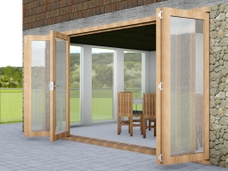Top Hung vs Bottom Rolling Bifold Doors: Things to Consider

Top-hung and bottom-rolling bifold doors are two common types of mechanisms for folding doors, each with its own advantages and disadvantages. Here’s a comparison of the two:
1. Top-Hung Bifold Doors
In top-hung bifold door applications, the weight of the door panels are supported from above through rollers located within an overhead track. As such, top hung applications require a strong, well supported overhead beam which can cater for the weight of the doors.
In addition to this, top hung bifold doors are typically favoured by homeowners and installers due to their smooth operation, easy adjustments, reduced maintenance and cleaner aesthetics. As the weight of the doors are supported from above, the doors generally operate more smoothly compared to bottom rolling systems. Top hung bifold doors also allow for easy lateral adjustments to raise and lower the door once fitted - this reduces any concerns over uneven flooring effecting the operation of the doors. Top hung bifold door applications also require less maintenance as dirt and debris is less likely to build up in the track, which in turn would effect the overall running of the system. Finally, top hung systems are typically designed with low profile thresholds which produce a more aesthic appealing appearance and create a more seamless transition to the outdoors.
The main thing to consider with top hung bifold doors is the structural support of the building. A strong overhead lintel is required to bear the weight of the doors, which can be a limitation in some buildings such as conservatories, orangeries and extensions.
2. Bottom-Rolling Bifold Doors
Bottom-rolling bifold doors use technology whereby the weight of the door panels are carried by the floor. The doors are support by a bottom track and rollers which are installed to the bottom of the doors.
Bottom rolling bifold doors are the perfect system for applications whereby overhead structural support is limited or for applications where bifold doors are being retrofitted - as bifold doors can be incorporated into the home without any major structural changes.
Things you must consider with bottom rolling bifold doors are:
- Uneven flooring can cause products with alignment and the overall operation of the doors.
- Increased maintenance required - bottom rolling systems use a bottom track which is prone to the build up of dirt and debris. This must be cleaned frequently to ensure the smooth operation of the roller running through the track when opening and closing the doors.
- Bottom rolling systems are typically designed with a large bottom track which is visible once installed and may interrupt the visual flow of the space.
Which to Choose?
Top-hung bifold doors are best suited to projects whereby aesthetics and smooth operation are key concerns, and where the structure can support the load from the top.
Bottom-rolling bifold doors are more appropriate when the building cannot support a top-hung system, or when retrofitting is necessary.
Choosing between the two depends on your specific needs, the structural constraints of the building, and the importance of appearance versus ease of installation and maintenance.
At P C Henderson, we offer both top hung and bottom rolling external bifold door hardware options. Our Securefold Pro offers a top hung folding door solution for wooden and aluminium doors weighing up to 100kg each. Alternatively, our Securefold Bottom Rolling uses innovative bottom rolling technology to cater for wooden or aluminium doors weighing up to 80kg each.
